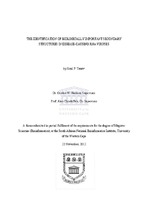| dc.description.abstract | Viral genomes consist of either deoxyribonucleic acid (DNA) or ribonucleic acid (RNA). The viral RNA molecules are responsible for two functions, firstly, their sequences contain the genetic code, which encodes the viral proteins, and secondly, they may form structural elements important in the regulation of the viral life-cycle. Using a host of computational and bioinformatics techniques we investigated how predicted secondary structure may influence the evolutionary dynamics of a group of single-stranded RNA viruses from the Picornaviridae family. We detected significant and marginally significant correlations between regions predicted to be structured and synonymous substitution constraints in these regions, suggesting that selection may be acting on those sites to maintain the integrity of certain structures. Additionally, coevolution analysis showed that nucleotides predicted to be base paired, tended to co-evolve with one another in a complimentary fashion in four out of the eleven species examined. Our analyses were then focused on individual structural elements within the genome-wide predicted structures. We ranked the predicted secondary structural elements according to their degree of evolutionary conservation, their associated synonymous substitution rates and the degree to which nucleotides predicted to be base paired coevolved with one another. Top ranking structures coincided with well characterized secondary structures that have been previously described in the literature. We also assessed the impact that genomic secondary structures had on the recombinational dynamics of picornavirus genomes, observing a strong tendency for recombination breakpoints to occur in non-coding regions. However, convincing evidence for the association between the distribution of predicted RNA structural elements and breakpoint clustering was not detected. | en_US |

